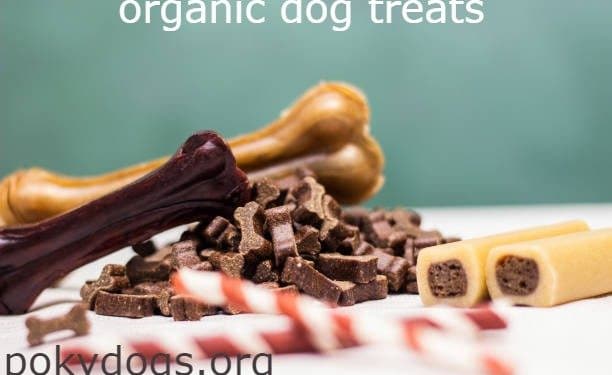Choosing Safe and Healthy Organic Dog Treats

Organic dog treats are jam-packed with healthy nutrients that can benefit your dog’s health. For a dog treat to be ‘organic’ it has to be free from any fillers, additives, pesticides, by-products, preservatives, artificial coloring, and any chemical fertilizers.
Many people choose to eat organically as it provides reassurance that the food is free of any harmful chemicals. Organic foods are bursting with vitamins, minerals, enzymes, and micro-nutrients. So by having your dog on an organic diet, you and your dog are getting a high amount of nutrients, which helps to build a strong immune system. See our homemade organic dog treat recipes.
1. Organic Dog Treats: Homemade Recipes
Organic dog treats are easy to make in the comfort of your own home. By baking your dogs treats at home, it’s the best way to be assured of the ingredients, and surprisingly, can help you save money too – and who doesn’t want a little extra cash in their pocket each week? If you’ve been looking and researching for healthy organic dog treats, then you have come to the right website.
Here, you will find a variety of recipes from homemade organic dog treats. They smell delicious when they are baking, so don’t feel too embarrassed if you sneak a bite of one because all our recipes are fit for human consumption and don’t contain any harsh ingredients only pure and natural ingredients. These treats are an excellent choice for any dog owner who is looking for a safe and healthy snack for their furry companion.
All of the homemade recipes on our website can be adapted to suit an organic diet, by simply switching any of the non-organic ingredients to organic.
2. Avoid Genetically Modified Organisms
The USDA does not allow GMOs (genetically modified organisms) in products that are certified as an organic product. For more information, click here.
Many commercial dog treat’s (and human foods) contain Genetically Modified Organisms) GMOs. Unfortunately, GMOs can have a detrimental effect on your dog’s health, and dog treats that contain GMOs are not required to be labeled!
GMOs can be very problematic to you and your four-legged friend. GMOs produce novel proteins that could have an impact on the immune system, lower content, and elevate potential toxins. They can contain harmful toxins, herbicides, and insecticides, such as glufosinate, glyphosate, and bacillus thuringeinsis. These chemicals have been known to cause kidney damage as well as an increased risk of reproductive health problems in dogs.
Given this, the best advice I can give you would be to ensure you look for the USDA Organic Certification logo on the outer package. If you want to know which commercial treats are free from GMOs, visit The GMO Project website.
3. Commercial Labeled Organic Dog Treats
Dog treats that are labeled ‘organic’ are almost always healthy dog treats. Manufacturers who label their treats ‘organic’ have followed a very specific and high standard of production, which requires certification to determine their organic status. A manufacturer cannot label its product organic unless they have followed the process and been certified.
The three levels of organic status:
- 100% Organic – means just that, totally and pure organic
- Organic – products labeled ‘organic’ must contain at least 95% of organic ingredients
- Made with Organic Ingredients – must show that the product contains at least 70% of certified organic ingredients
The standard rules for organic treats are as follows:
- Must be made without artificial fertilizers or pesticides
- Be free from human or industrial waste contamination
- Be processed without ionizing radiation or food additives
- If the ingredients come from animals, they must have been fed a healthy diet and raised without the use of growth hormones and general use of antibiotics
4. Commercial, Natural & Organic Dog Treats:
Understanding The Difference?
Dog treats labeled as ‘natural’ or ‘organic’ are safer and have better nutrients than regular treats. They also have fewer harmful ingredients. However, natural and organic treats are not the same. Here’s a chart to show the differences and ingredients of each.
| INGREDIENTS | COMMERCIAL | NATURAL | ORGANIC |
| HIGH HEAT TREATMENT
ANTIBIOTICS HERBICIDES PESTICIDES HUMAN GRADE MEATS ANIMAL BY PRODUCTS ARTIFICIAL COLORING ‘FILLER’ FOODS |
YES
YES YES YES NO YES YES YES |
MAYBE
MAYBE MAYBE MAYBE MAYBE NO NO NO |
MAYBE
NO NO NO YES NO NO NO |
Commercial dog treats lose their nutritional value due to high-heat processing. The resulting proteins and enzymes are useless for dogs. Toxic ingredients like antibiotics, pesticides, and herbicides are commonly found in these treats and can cause chronic diseases. Organic dog treats do not have these harmful chemicals. Look for “human grade” meat on the label of your dog’s food and treats to ensure safety for both humans and dogs. “Feed grade” meat is only for animals, not people. Keep reading to learn about dead animals.
Animal By-Products
Dog treats contain leftovers from human food called Animal By-Products. These leftovers can be feathers, fat, flesh, blood, cartilage, and bones. However, it’s not ideal to use them in dog treats.
Dog treats use animal by-products from animals killed for food or from sick ones. They can also come from dead animals found on farms, ranches, markets, or animal shelters.
Stores and restaurants can reuse food waste. They can make a low-quality meal called ‘Meat and Bone Meal’. It’s made from bones, gristle, and tendons of slaughtered animals.
Artificial Coloring
Natural and Organic dog treats may not be visually appealing because they lack harmful artificial colors. Commercial dog treats use artificial coloring to attract dog owners. However, dogs are color blind and only care about the taste of the treat. Therefore, we should focus on the ingredients that are healthy for our dogs, not the color.
Fillers In Dog Treats
‘Fillers’ are usually carbohydrates, on the other hand, are very different and are harmful. I would highly recommend buying natural or organic treats because these are more likely to contain a high amount of vitamins and nutrient-rich source of carbohydrates.
Here I’ve compiled a list of the most typical additives found in store-bought dog treats. You may want to avoid using the following binders:
Corn syrup is similar to sugar and can cause health problems in dogs like obesity, diabetes, hyperactivity, and personality changes. Chemicals like BHA and BHT can cause cancer in dogs. Dogs should avoid exposure to these chemicals. Some dog treats contain antifreeze compounds to keep them dry and bacteria-free.
This can progress to intestinal blockages or cancerous lesions in the intestines of the dog.









